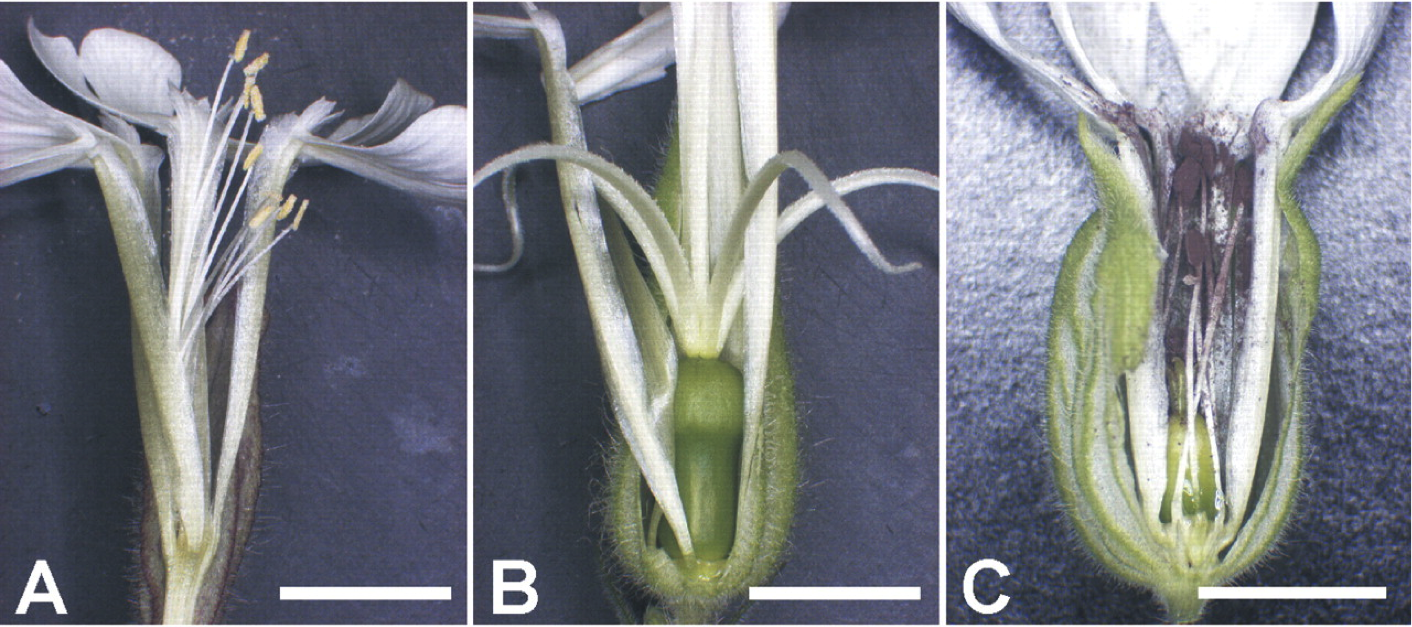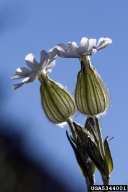Interactions
Interactions with Other Organisms
Animals
Silene latifolia has several
interactions with other animals. This plant is a viable food source for both generalist
and specialist organisms (Bucheli et al., 2001).
Generalist species are organisms that can live in a variety of
environments, while specialists are organisms that have very
specific habitats. Because Silene latifolia is found in
dry, sunny climates, it is able to appeal to generalist species.
Because it also inhabits more specific environments, such as
around roads and waste plants, it is able to appeal to
specialist organisms. Some animals that eat this plant include
aphids and catipillars.
Another way Silene
latifolia interacts with organisms is through the process
of pollination. Pollination of Silene latifolia occurs by
a mutalistic interaction between the plant and animals. This
pollination occurs both at night
.jpg) (moths) and during the day
(bees
and
butterflies). Though
bees
pollinate in the early evening, the
most common is moth pollination during the evening. Moths have a
unique interaction with Silene latifolia because the
moth not
only pollinates S. latifolia, but at times, the moth
will also use the plant to lay its
eggs (Garden
Organic, 2013). This interaction is not mutualistic like the pollination.
When the moth lays its eggs, the larvae will
(moths) and during the day
(bees
and
butterflies). Though
bees
pollinate in the early evening, the
most common is moth pollination during the evening. Moths have a
unique interaction with Silene latifolia because the
moth not
only pollinates S. latifolia, but at times, the moth
will also use the plant to lay its
eggs (Garden
Organic, 2013). This interaction is not mutualistic like the pollination.
When the moth lays its eggs, the larvae will eat the fruit
seeds thereby decreasing the plant's fruit output. Whether
the pollination of the flower outways the decreased amount of
seeds left by the larvae is still being experimented (Labouche
and Bernasconi, 2010).
For more information about the pollination of silene
latifolia, check out the
reproduction page.
eat the fruit
seeds thereby decreasing the plant's fruit output. Whether
the pollination of the flower outways the decreased amount of
seeds left by the larvae is still being experimented (Labouche
and Bernasconi, 2010).
For more information about the pollination of silene
latifolia, check out the
reproduction page.
Humans
Silene latifolia has little interactions with humans.
Because it has saponins, which are toxic at high doses, it is
advised not to eat large quantities of this plant. Also, the
Caryophyllaceae family contians weed species which includes
Silene latifolia. It is considered a weed because it grows
on cultivated land as a wild plant that has no use. One positive
interaction it has with humans is it can be used to make soap
substitutes (PFAF,
2012).
Interactions with an STD
Silene Latifola has a
parasitic relationship with the anther-smut fungus, which causes
an “STD” like effect on the plant's reproductive system (Bucheli,
et al., 2001).

The figure above depicts the anthers beggining to produce
the spores instead of pollen. Picture A shows the normal pollen
then to C where the spores have taken place of the pollen.
.png) This fungus produces dark fungal spores, which causes the
Anther-Smut disease throughout the family Caryophyllaceae. The
fungal disease is spread through the pollen of Silene
latifolia. It sterilizes the plant, and then prompts the
female to create male anthers that produce fungal spores instead
of pollen. The fungal disease also increases the reproduction
rate of Silene latifolia once it's producing fungal spores from the anthers.
This parasitic interaction allows for optimal growth and
reproduction of the fungus while in turn sterilizing the plant.
It is considered a plant STD because it is transferred through
the pollen and affects the reproductive organs of a plant.
On the picture to the left, the flowers on the left are
Silene latifolia unaffected by the Angus-Smut fungus, while
the flowers of Silene latifolia on the left are
infected. Major differences between figure g anf h show the
effects the fungus has on the germination rate of the flowers on
Silene latifolia.
This fungus produces dark fungal spores, which causes the
Anther-Smut disease throughout the family Caryophyllaceae. The
fungal disease is spread through the pollen of Silene
latifolia. It sterilizes the plant, and then prompts the
female to create male anthers that produce fungal spores instead
of pollen. The fungal disease also increases the reproduction
rate of Silene latifolia once it's producing fungal spores from the anthers.
This parasitic interaction allows for optimal growth and
reproduction of the fungus while in turn sterilizing the plant.
It is considered a plant STD because it is transferred through
the pollen and affects the reproductive organs of a plant.
On the picture to the left, the flowers on the left are
Silene latifolia unaffected by the Angus-Smut fungus, while
the flowers of Silene latifolia on the left are
infected. Major differences between figure g anf h show the
effects the fungus has on the germination rate of the flowers on
Silene latifolia.
Interactions with the Environment
Silene latifolia is a weed that obtains nutrients from the
ground and sunlight. It grows well in
fields and along roads or in waste plants (Brandeis,
2004). It
also is considered a wildflower that grows naturally throughout
North America and Europe. Farmers often considered it a weed
because it grows on cultivated land, but nature enthusiasts
often describe it as a wildflower growing in open fields. To
learn more about the habitat and geography
click here. It
uses the environment to grow using the nutrient rich soil for a
food source. Silene latifolia can be harmful to the
environment because it is an invasive species, which means it can take nutrients from surrounding
sources preventing those sources from receiving proper nutrients.

Hybrid Zones
Hybrid zones are locations where two
subspecies of the same species can reproduce. In Switzerland,
there are hybrid zones between Silene latifolia and Silene
Dioica. Interactions between the subspecies allow for sexual
reproduction, which produce viable offspring (Minder,
et al., 2007).